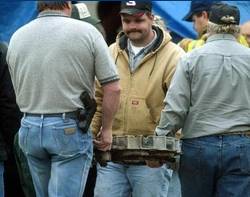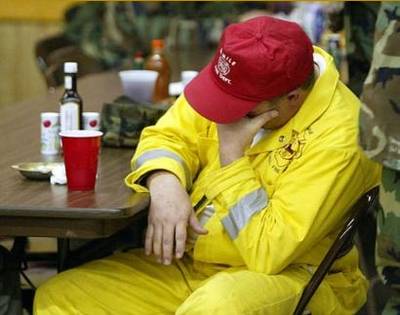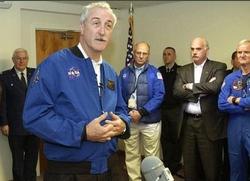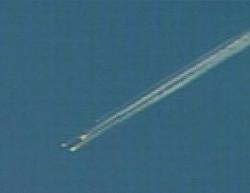Shuttle Debris Will Be Returned To KSC
 The Space Shuttle Columbia, doomed to a
firey breakup on re-entry just 16 minutes before its scheduled
touchdown at the Kennedy Space Center, will begin its final journey
home this week. Debris from Texas and Louisiana, which is now being
sent to Barksedale AFB in Shreveport, will be sent to Cape
Canaveral around the middle of next week, according to NASA
officials.
The Space Shuttle Columbia, doomed to a
firey breakup on re-entry just 16 minutes before its scheduled
touchdown at the Kennedy Space Center, will begin its final journey
home this week. Debris from Texas and Louisiana, which is now being
sent to Barksedale AFB in Shreveport, will be sent to Cape
Canaveral around the middle of next week, according to NASA
officials.
"The first pieces are almost ready to ship, and Kennedy is
preparing a facility for them," said NASA spokesman Dave
Drachlis.
80 Percent Of Known Debris Recovered
Meantime, exhausted search crews along the Texas-Louisiana
border are getting more help. Additional recovery workers continue
pouring into towns like Nacogdoches, Hemphill and San Augustine.
Some 300 National Guard troops who have been helping find and mark
shuttle debris are being moved from Nacogdoches to Sabine County to
augment recovery efforts there.
Nacogdoches County Sheriff Tommy Kerss said 80-percent of the
known debris sites in his jurisdiction had been cleared. He
expected all known sites would be cleaned up before Sunday
night.
"The drive and human spirit being displayed throughout all of
this has been tremendous," Kerss said.

The most significant discovery in the debris field so far has
been a 2-foot section of shuttle wing, including the carbon-covered
leading edge designed to protect Columbia's insulating
tiles as the spacecraft heats to 3,000 degrees re-entering the
atmosphere.
If that section came from the troubled left wing, where
temperatures surged in the shuttle's final moments and sensors
failed in rapid sequence, it could provide hard evidence of what
went wrong.
O'Keefe: Wish We Could Have Met Under
Different Circumstances
Investigators hadn't yet determined which wing the fragment
belonged to, but should know "in relatively short order," NASA
Administrator Sean O'Keefe said Saturday after a memorial service
at Louisiana's Barksdale Air Force Base, where pieces of the
shuttle are being stored.
In Lufkin (TX), site of the recovery command post, hundreds of
workers paused at eight Saturday morning - one week to the
moment after the shuttle disaster - to remember the seven
astronauts who died when Columbia broke up on
re-entry.
 O'Keefe offered his thanks to Lufkin.
O'Keefe offered his thanks to Lufkin.
"The good people of Lufkin could not have possibly planned for
1,500 folks to suddenly descend from 20 different federal agencies
and state and local organizations," said O'Keefe.
"It is a fervent wish we could have made all your acquaintances
under different circumstances."
Lightning Strike?
NASA officials are now reportedly investigating the possibility
Columbia broke-up over the skies of Texas after being
struck by high altitude lightning.
Photographs taken by an amateur astronomer in San Francisco
shows a purplish electrical bolt striking the ill-fated shuttle
soon after it re-entered the Earth's atmosphere and streaked across
the California sky.
The digital image is one of five snapped by the shuttle buff as
sensors on the doomed vehicle began showing the first indications
of trouble, with temperature spikes on the left wing and wheel
well.
 Less
than seven minutes later the shuttle, carrying six Americans and
one Israeli astronauts, disintegrated over Texas. On Friday, NASA
officials said they were moving away from an initial theory that
the tragedy was caused by insulation foam, on the external fuel
tank, breaking-off during the January 16 launch and striking the
left side of the 21-year-old shuttle.
Less
than seven minutes later the shuttle, carrying six Americans and
one Israeli astronauts, disintegrated over Texas. On Friday, NASA
officials said they were moving away from an initial theory that
the tragedy was caused by insulation foam, on the external fuel
tank, breaking-off during the January 16 launch and striking the
left side of the 21-year-old shuttle.
The only thing ruled out, definitively and swiftly, is that
Columbia was brought down by terrorists. With Israel's
first astronaut on board, terrorism had been the major concern for
the shuttle's launch and its return to Florida 16 days later.
Federal officials said the shuttle was too high when it broke up
207,135 feet to be reached by any surface-to-air missile.
 ANN's Daily Aero-Term (05.07.25): Terminal Radar Service Area
ANN's Daily Aero-Term (05.07.25): Terminal Radar Service Area ANN's Daily Aero-Linx (05.07.25)
ANN's Daily Aero-Linx (05.07.25) Classic Aero-TV: Anousheh Ansari -- The Woman Behind The Prize
Classic Aero-TV: Anousheh Ansari -- The Woman Behind The Prize NTSB Prelim: Bell 206B
NTSB Prelim: Bell 206B Airborne-NextGen 05.06.25: AF Uncrewed Fighters, Drones v Planes, Joby Crew Test
Airborne-NextGen 05.06.25: AF Uncrewed Fighters, Drones v Planes, Joby Crew Test






